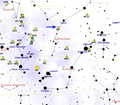Astronomy:Messier 9
| Messier 9 | |
|---|---|
| File:Globular cluster Messier 9 (captured by the Hubble Space Telescope).tif Messier 9 by HST | |
| Observation data (J2000 epoch) | |
| Class | VIII[1] |
| Constellation | Ophiuchus |
| Right ascension | 17h 19m 11.78s[2] |
| Declination | –18° 30′ 58.5″[2] |
| Distance | 25.8 kly (7.9 kpc)[3] |
| Apparent magnitude (V) | 7.7[4] |
| Apparent dimensions (V) | 9.3′[5] |
| Physical characteristics | |
| Mass | 4.22×105[3] M☉ |
| Radius | 45 ly[3] |
| Metallicity | [math]\displaystyle{ \begin{smallmatrix}\left[\ce{Fe}/\ce{H}\right]\end{smallmatrix} }[/math] = –1.77[3] dex |
| Estimated age | 12.0 Gyr[6] |
| Other designations | HD 156587, NGC 6333[7] |
Messier 9 or M9 (also designated NGC 6333) is a globular cluster in the constellation of Ophiuchus. It is positioned in the southern part of the constellation to the southwest of Eta Ophiuchi, and lies atop a dark cloud of dust designated Barnard 64.[5][8] The cluster was discovered by French astronomer Charles Messier on June 3, 1764, who described it as a "nebula without stars".[9] In 1783, English astronomer William Herschel was able to use his reflector to resolve individual stars within the cluster. He estimated the cluster to be 7–8′ in diameter with stars densely packed near the center.[10]
M9 has an apparent magnitude of 7.9, an angular size of 9.3′, and can be viewed with a small telescope.[5] It is one of the nearer globular clusters to the center of the galaxy as is around 5,500 light-years from the Galactic Center. Its distance from Earth is 25,800 light-years.
The total luminosity of this cluster is around 120,000 times that of the Sun, the absolute magnitude being -8.04. The brightest individual stars in M9 are of apparent magnitude 13.5, making them visible in moderately sized telescopes. There have been 24 variable stars found in M9: 21 RR Lyrae variables, plus a long-period variable, Type II Cepheid, and an eclipsing binary. No blue stragglers or SX Phoenicis variables have been discovered. Based upon the periods of the RR Lyr variables, this cluster is classified as an Oosterhoff type II globular, which precludes an extra-galactic origin.[11]
At about 80' (1 1⁄3 degrees) to the northeast of M9 is the dimmer globular cluster NGC 6356, while about the same to the southeast is the globular NGC 6342.
Gallery
Messier 9, from 2MASS
See also
References
- ↑ Shapley, Harlow; Sawyer, Helen B. (August 1927), "A Classification of Globular Clusters", Harvard College Observatory Bulletin 849 (849): 11–14, Bibcode: 1927BHarO.849...11S.
- ↑ 2.0 2.1 Formiggini, Liliana et al. (May 2002), "Hidden subluminous stars among the FAUST UV sources towards Ophiuchus", Monthly Notices of the Royal Astronomical Society 332 (2): 441–455, doi:10.1046/j.1365-8711.2002.05327.x, Bibcode: 2002MNRAS.332..441F.
- ↑ 3.0 3.1 3.2 3.3 Boyles, J. et al. (November 2011), "Young Radio Pulsars in Galactic Globular Clusters", The Astrophysical Journal 742 (1): 51, doi:10.1088/0004-637X/742/1/51, Bibcode: 2011ApJ...742...51B.
- ↑ "Messier 9". https://messier.seds.org/m/m009.html.
- ↑ 5.0 5.1 5.2 Gilmour, Jess K. (2012), The Practical Astronomer's Deep-sky Companion, The Patrick Moore Practical Astronomy Series, Springer Science & Business Media, p. 75, ISBN 978-1447100713, https://books.google.com/books?id=HyMRBwAAQBAJ&pg=PA75.
- ↑ Koleva, M. et al. (April 2008), "Spectroscopic ages and metallicities of stellar populations: validation of full spectrum fitting", Monthly Notices of the Royal Astronomical Society 385 (4): 1998–2010, doi:10.1111/j.1365-2966.2008.12908.x, Bibcode: 2008MNRAS.385.1998K
- ↑ "M 9". SIMBAD. Centre de données astronomiques de Strasbourg. http://simbad.u-strasbg.fr/simbad/sim-basic?Ident=M+9.
- ↑ O'Meara, Stephen James (2014), Deep-Sky Companions: The Messier Objects, Cambridge University Press, p. 71, ISBN 978-1107018372, https://books.google.com/books?id=fDQZAwAAQBAJ&pg=PA71.
- ↑ Machholz, Don (2002), The Observing Guide to the Messier Marathon: A Handbook and Atlas, Cambridge University Press, p. 23, ISBN 978-0521803861, https://books.google.com/books?id=iGI1wjkGLkQC&pg=PA23.
- ↑ Klein, Hermann Joseph (1901), Star Atlas, Society for promoting Christian knowledge, p. 55, https://books.google.com/books?id=XszaAAAAMAAJ&pg=PA55.
- ↑ Arellano Ferro, A. et al. (September 2013), "A detailed census of variable stars in the globular cluster NGC 6333 (M9) from CCD differential photometry", Monthly Notices of the Royal Astronomical Society 434 (2): 1220–1238, doi:10.1093/mnras/stt1080, Bibcode: 2013MNRAS.434.1220A.
External links
- Messier 9, SEDS Messier pages
- M9, Galactic Globular Clusters Database page
- The glittering stars of Messier 9, March 16, 2012, Tg Daily Staff, TG Daily
- NASA Astronomy Picture of the Day: Messer 9 Close Up (23 March 2012)
- Messier 9 on WikiSky: DSS2, SDSS, GALEX, IRAS, Hydrogen α, X-Ray, Astrophoto, Sky Map, Articles and images
Coordinates: ![]() 17h 19m 11.78s, −18° 30′ 58.5″
17h 19m 11.78s, −18° 30′ 58.5″
 |




